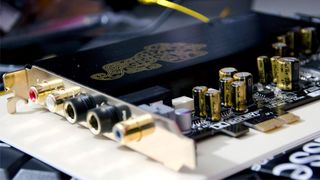The reality is that unless you are an extreme gamer, or are looking to get into the world of hardcore audio editing, sound cards are not going to be that much of an improvement over the audio from your motherboard. However, there are certain pros and cons to consider before you dismiss sound cards completely. Here they are.
What different types of PC audio are there?
Audio comes in two different formats: analog and digital. Computers are what we call digital systems, which means that they can only produce or manipulate sound in a digital format. The problem is that, in the real world, all audio is found or created in an analog format. All speakers produce analog signals; digital speakers, the ones we use for computers or home theater systems (opens in new tab), are analog speakers that are able to convert the digital signal to the analog format. A digital-to-analog converter (DAC) is used for this process and is incorporated into many of the speakers we see from day to day. All motherboards have a chip called a codec (coder/decoder) that is able to covert digital signals to analog signals and vice-versa. You can find external DAC devices in some of the best headphones (opens in new tab), especially if you look at specialist gaming versions.
Onboard audio - pros and cons
All motherboards on the market come with embedded sound cards, or onboard audio. The problem is that since motherboards need to be small enough to fit into your tower, they have limited space for the sound card. As such, onboard audio is not able to produce the same quality of audio as a dedicated sound card. Many of the features needed to produce clear, crisp sound simply can’t be added to onboard sound cards. One major advantage of using onboard audio is obviously the cost. Not only do you save money on the sound card, but you also save a lot of money on new speakers or an expensive headset. You will still be able to listen to the same music or play the same games as someone with a dedicated sound card, but you won’t quite have the same level of sound quality. If you own one of the best laptops (opens in new tab), you won’t have the option to add a sound card, so if you’re looking to improve audio, we recommend a headset with an external DAC, like the Steelseries Arctis Pro (opens in new tab).
Dedicated sound cards - pros and cons
Dedicated sound cards have a number of improved or added features, which in turn produce better sound quality all around. Features like higher signal-to-noise ratios, lower harmonic distortion, 24-bit sample rates, 192-kHz resolutions and of course additional APIs. These additional features are what truly make a dedicated sound card worth the time and money it costs to install them and set them up to work properly. One thing to keep in mind is that you will need a good set of speakers or a nice headset to truly hear the difference. The main downside? Most will never really need that extra audio fidelity. Sound cards are not for everyone. Not only do you need to buy the sound card itself, but you also need additional equipment to get the most out of your new piece of hardware. However, there are a variety of price ranges and types of sound cards, which makes it easy to start simple and upgrade once you have a better understanding of how sound cards work. If you do decide to choose a sound card, the one you should consider is the Sound Blaster Z (opens in new tab), which is an absolute monster available for a reasonable price.
